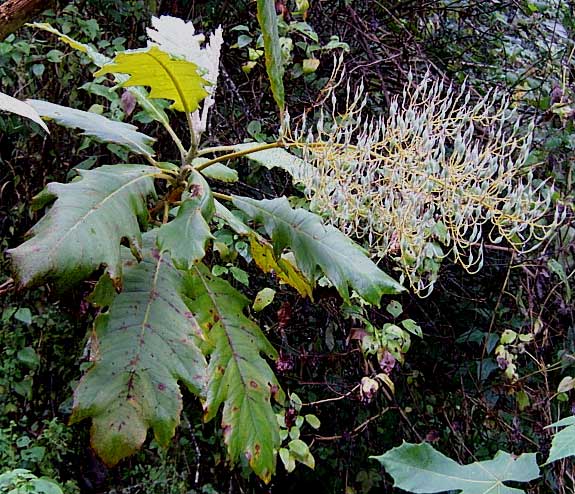Excerpts from Jim Conrad's
Naturalist Newsletter
from the February 9, 2007 Newsletter issued from Sierra Gorda Biosphere Reserve, QUERÉTARO, MÉXICO
TREE POPPIES

One plant you can't miss while driving through the mountains is the shrub shown above. It's maybe 15 feet high, with large leaves so similar to oak leaves that at first you assume that the plants are indeed oaks. However, then you notice that in a very un-oaklike manner the stems end in large panicles of small fruits.
I had the hardest time figuring out what this plant was until one day I tore a leaf margin and the leaf "bled" an orangish latex. Only a small fraction of plant families produce colored latex, so that was a good clue. I'd just returned from spending the summer in Kentucky where colored-latex-bleeding poppies had grown in the gardens, but I'd never heard of a woody member of the Poppy Family. Still, I checked out the list of Poppy Family members growing in this area and, sure enough, there was a woody species, sometimes called Tree Poppy, BOCCONIA FRUTESCENS. Google soon turned up pictures of that species, which confirmed the identification.
You can see in my picture that Tree Poppies don't look anything like garden poppies. The small items borne in the inflorescence are immature capsular fruits. Flowers are small and not at all showy, though large clusters of them are conspicuous.
Tree Poppy is native from Mexico to South America, and is invading new territory. In Hawaii it's listed as a noxious weed, and there it's being realized that the species is hard to get rid of. The leaves' waxy surfaces protect it from herbicides, the plant sprouts easily from tiny parts not completely removed from the soil, birds disperse the fruits, and each plant produces very many seeds.
However, here, Tree Poppy is at home and its enemies have evolved with it. You seldom see more than an individual plant growing here and there. Leaves of the one in my picture are blotchy with colonies of parasitic fungus. Here, Tree Poppy is just an attractive element of the local flora and no one would think of it as weedy.